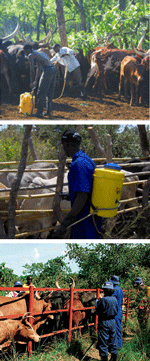STAMP OUT SLEEPING SICKNESS
|
|
Introduction to the stamp out sleeping sickness project
Background to sleeping sickness in Uganda
The spread of sleeping sickness in Uganda
Communication of research to communities and policy makers
|
Background to sleeping sicknessThere are two strains of parasite, Trypanosoma brucei gambiense and Trypanosoma brucei rhodesiense, that cause Sleeping Sickness. Both forms of Sleeping Sickness are prevalent throughout the African continent, with the diseases being geographically separated by the Rift Valley. It has been estimated by the World Health Organization that there is an incidence of at least 300,000 cases, although this is generally thought to be an under-estimate since many cases are undiagnosed. 60 million people live in risk areas, and as many of these have poor access to diagnostic and health care facilities, hence under-reporting rates are high. It is anticipated that at least one million people per year are killed of the two strains of Sleeping Sickness in sub-Saharan Africa, an emerging neglected disease. The two different forms of the disease require different treatment. Early diagnosis in people is essential, but expensive to organise in a systematic way. Diagnosis and treatment in humans is problematic and treatment toxic. However in Uganda it has been shown that the major reservoir of disease is in livestock which are cheap to treat. The Universities of Makerere and Edinburgh are working in partnership with The Ugandan ministries, COCTU and livestock owners, veterinary professionals and students, with the support of company CEVA Santé Animal and IK Investment Partners, to approach the problem of Sleeping Sickness from a new angle. Rather than trying to diagnose and treat the parasite once it is in the human, the campaign aims to eradicate the parasite from the reservoir, the cattle population. Symptoms of Sleeping SicknessHaving been passed to the human through the bite of an infected tsetse fly, the parasites multiply in subcutaneous tissues, blood and lymph. In time, the parasites cross the blood-brain barrier to infect the central nervous system. After a first "common" stage of the disease (fever, headaches, joint pains and itching), the second stage begins when the parasite crosses the blood-brain barrier and invades the central nervous system. In general this is when the signs and symptoms of the disease appear: confusion, sensory disturbances and poor coordination. Disturbance of the sleep cycle, which gives the disease its name, is an important feature of the second stage of the disease. Without treatment, Sleeping Sickness is always fatal. The two types of Sleeping Sickness are significantly different in their symptoms – the T. b. gambiense is chronic, with individuals carrying the parasite without symptom for long periods and when symptoms appear, the patient is often already at an advanced stage. This form represents more than 90% of reported cases of Sleeping Sickness. T. b. rhodesiense is acute, with symptoms revealing themselves soon after infection (within a few months or weeks), with the disease developing rapidly.
This website holds no responsibility for the information that external links may contain.
|
 |